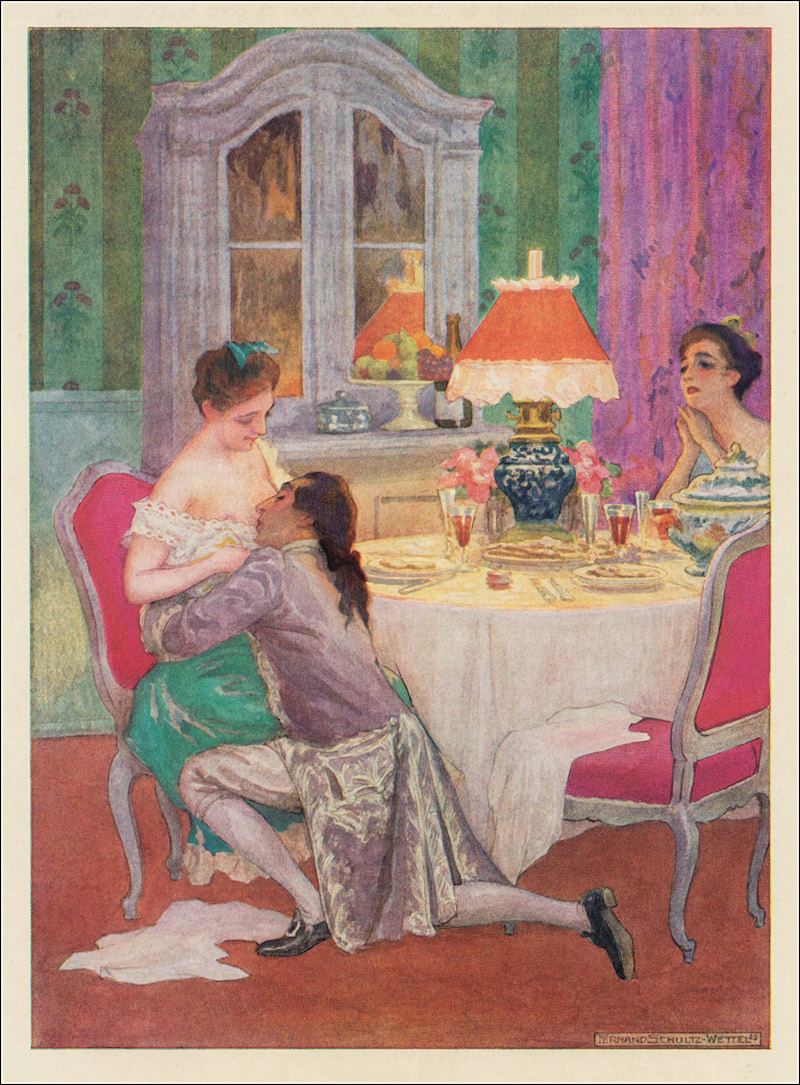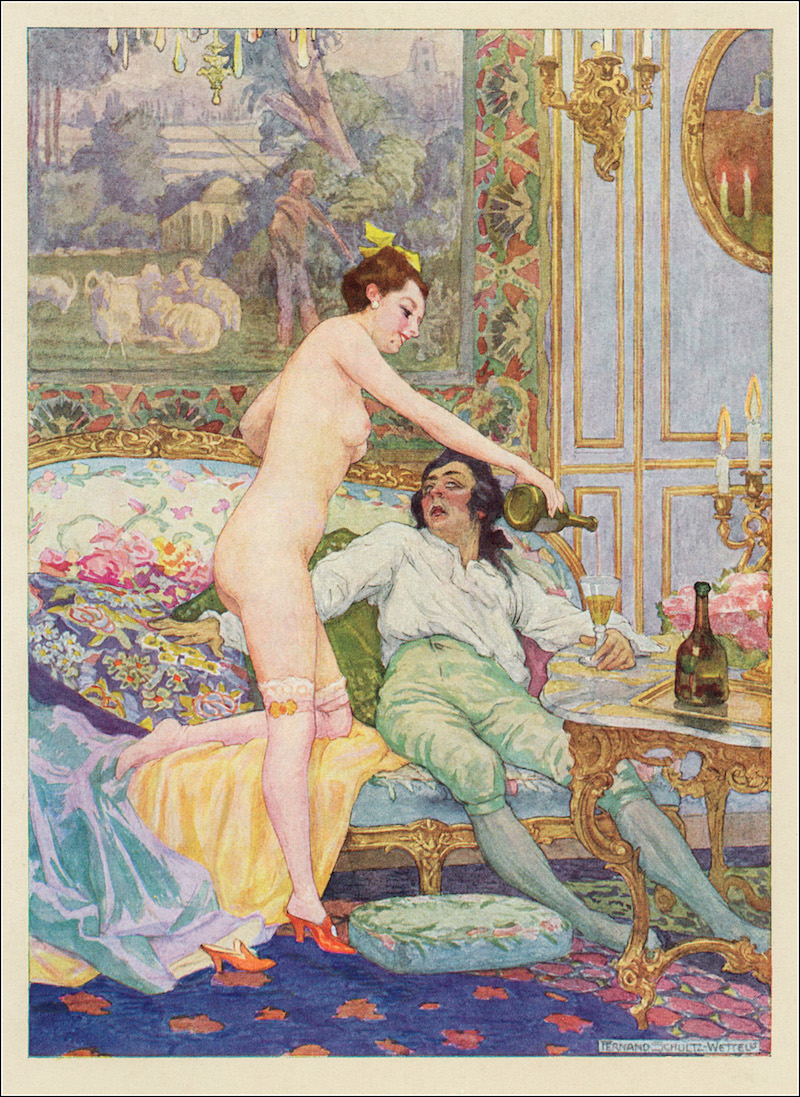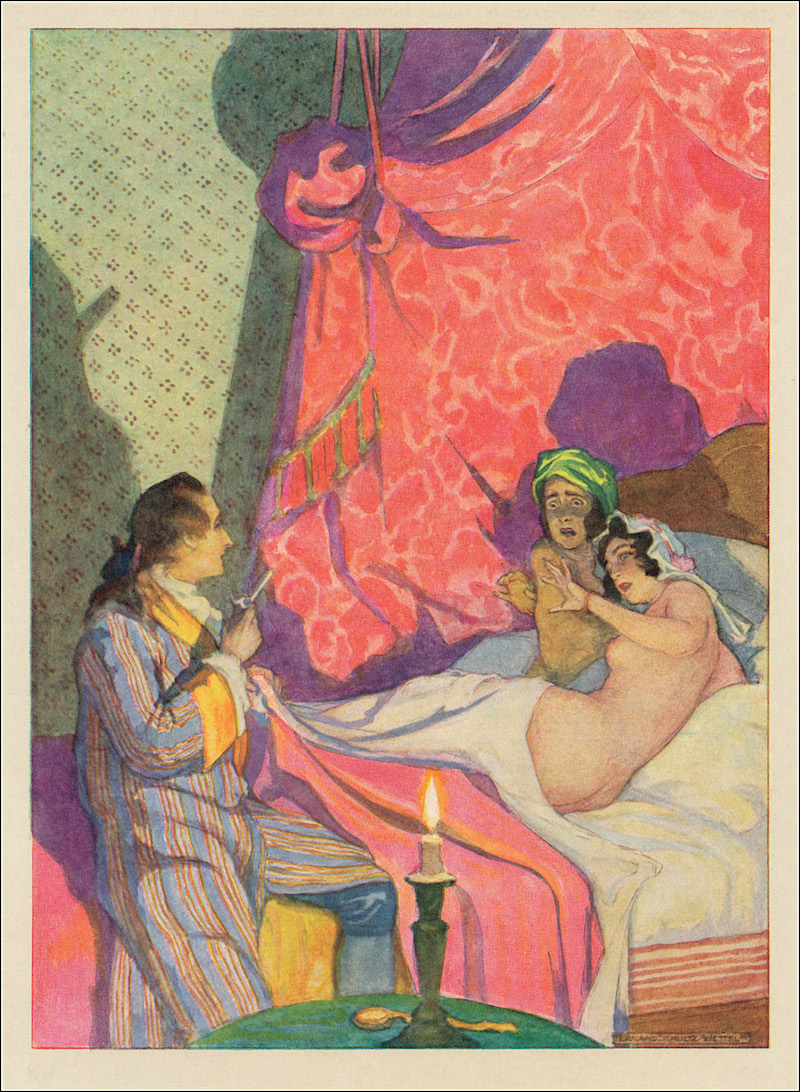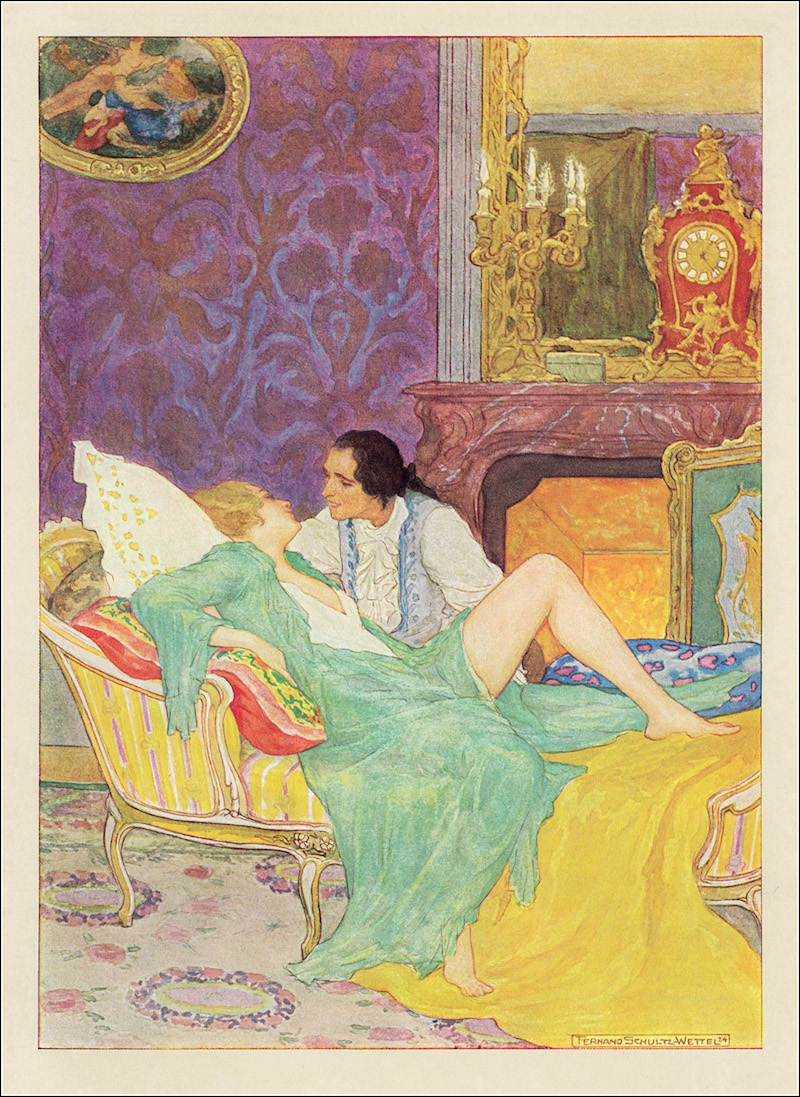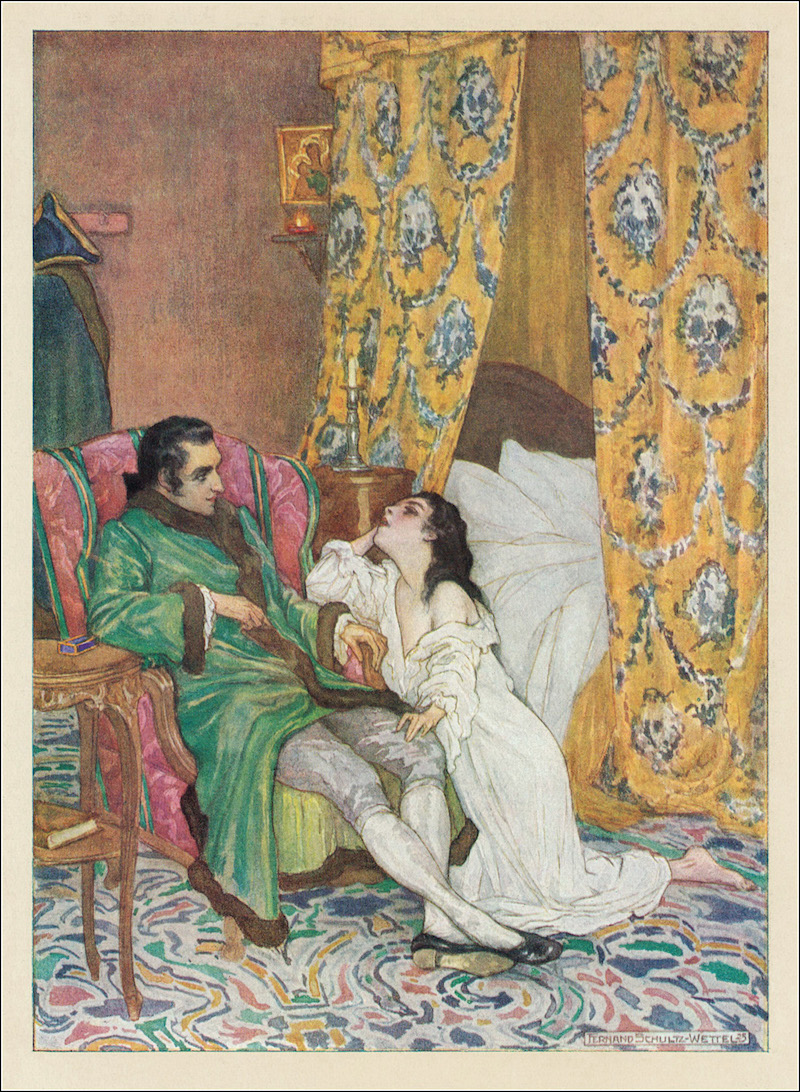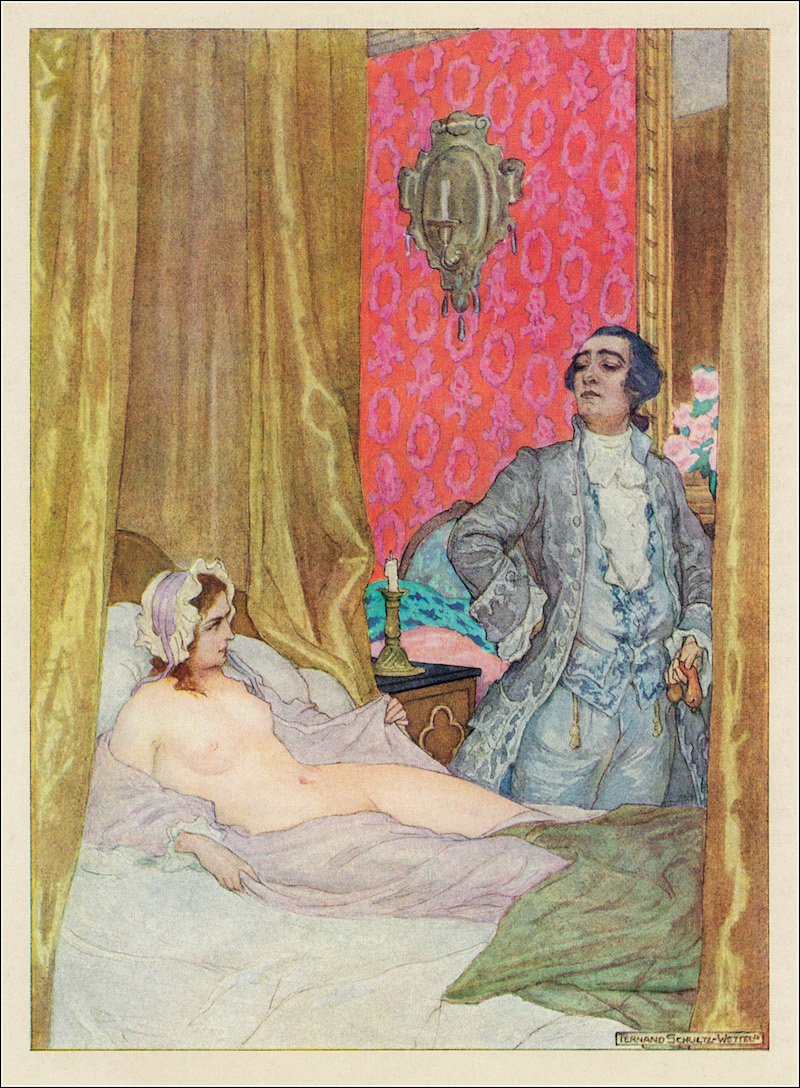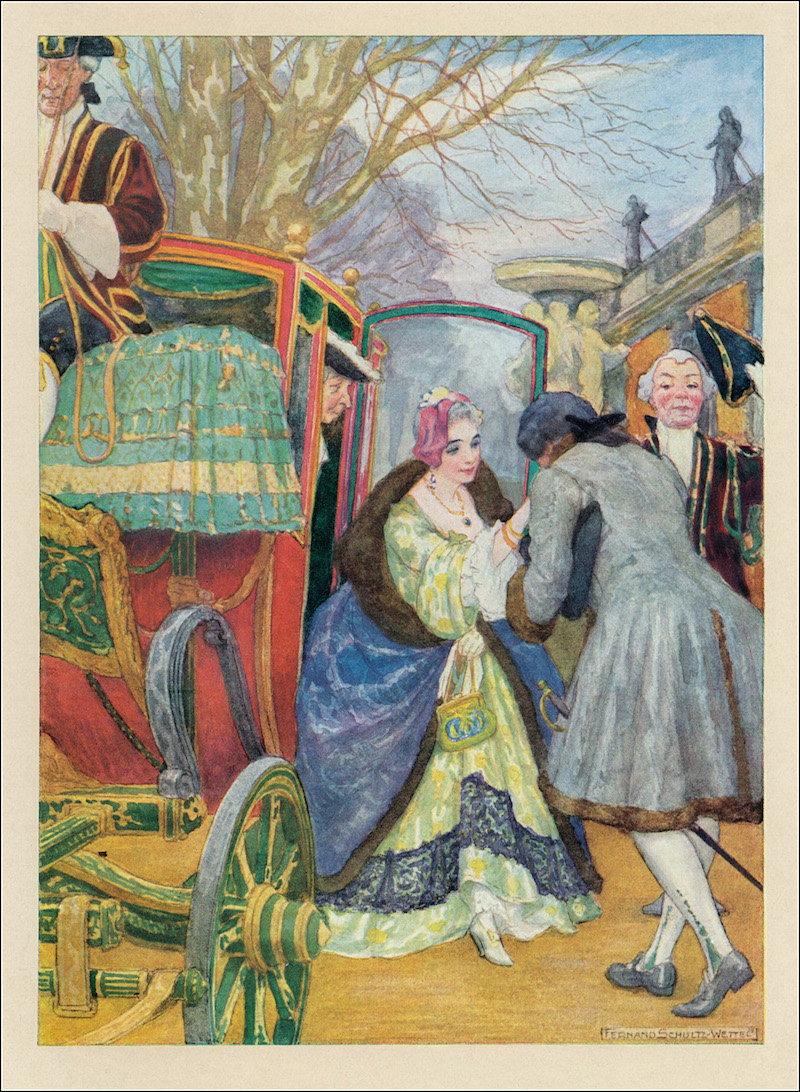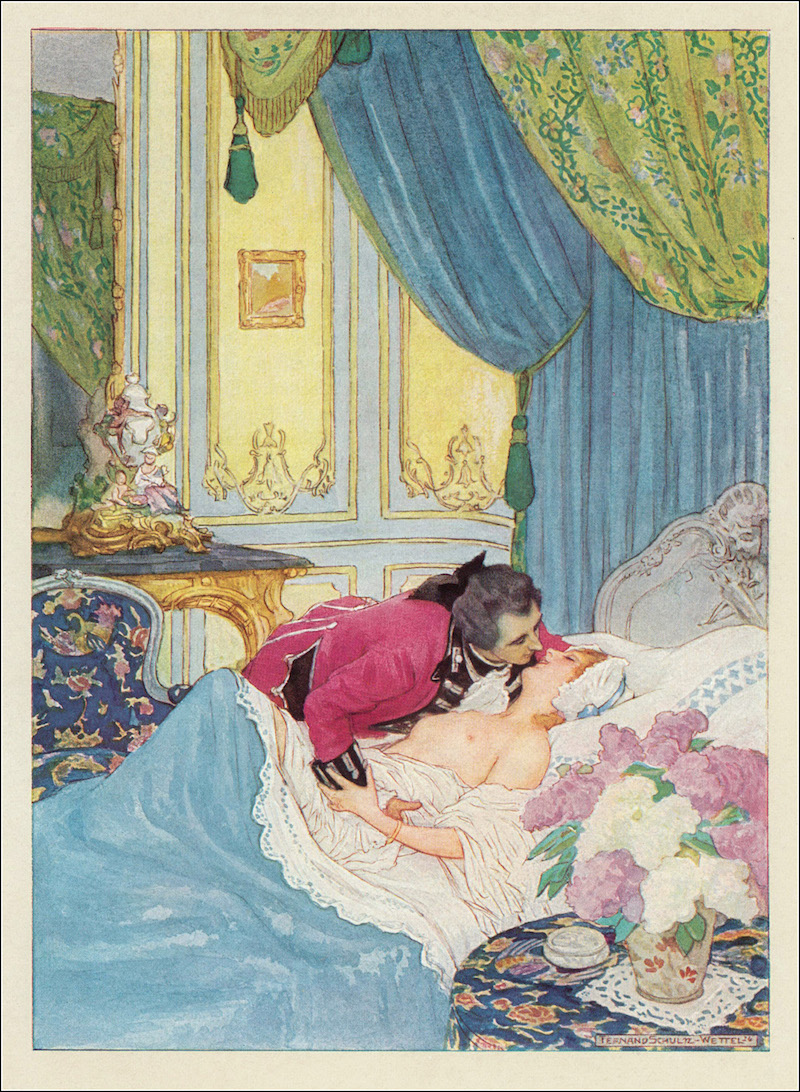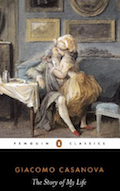 “I am writing ‘My Life’ to laugh at myself, and I am succeeding,” writes Giacomo Casanova on January 10, 1791 (Pizzamiglio, 2005, p. ix). Born on April 2, 1725, Casanova sets of on a life of learning, travel, intrigue, seduction and all-round adventure. At the age of sixty-four, suffering from deep melancholy, his doctor advises him to start writing his memoirs as a remedy for his black bile (p. xv) and so he does, until his death in 1798. The result is the impressing The Story of My Life, shocking and fascinating many readers with its countless episodes on love and seduction of women, but more importantly opening an authentic window into the world of eighteenth century European social life.
“I am writing ‘My Life’ to laugh at myself, and I am succeeding,” writes Giacomo Casanova on January 10, 1791 (Pizzamiglio, 2005, p. ix). Born on April 2, 1725, Casanova sets of on a life of learning, travel, intrigue, seduction and all-round adventure. At the age of sixty-four, suffering from deep melancholy, his doctor advises him to start writing his memoirs as a remedy for his black bile (p. xv) and so he does, until his death in 1798. The result is the impressing The Story of My Life, shocking and fascinating many readers with its countless episodes on love and seduction of women, but more importantly opening an authentic window into the world of eighteenth century European social life.
Giacomo Casanova was a Venetian, and for centuries the Venetians had been trading partners with the Ottoman Empire. At the age of nineteen, Casanova joins the retinue of the Venetian ambassador Venier, who is on his way to take his post as bailo at Constantinople (Casanova, 2005, p. 108). Casanova spends three months at the Sublime Port, which he describes detailedly in his memoirs.
Casanova was not just a Venetian, he was a European. In the relationship between Europe and the Ottoman Empire, the latter has often functioned as ‘the other’ in European identity formation (Neumann, 1999). In this formation, descriptions of ‘the other’ – be it the Ottoman, the Muslim, the Indian or the African other – have often been distorted, either to legitimize domination of the other or as a result of dominating the other (Said, 1978).
When discussing Edward Said’s Orientalism, Emmanuel Sivan writes that “against the totalizing, essentializing analysis of Orientalism offered by Said … reviewers suggest a case-by-case examination of its product” (1985, p. 139). In this essay I want to make one such examination. It is my aim to analyse how the Venetian writer Casanova describes Istanbul and its inhabitants in his book The Story of My Life.
Can we say that Casanova has an Orientalist disposition in the way Said defined Orientalism? Should we see Casanova’s written adventures in Istanbul as a veiled reflection on European society? How does Casanova use the Ottoman ‘Other’? In order to make this examination, I will first briefly summarize Casanova’s Turkish adventures in the historic context of Venetian-Ottoman relations. Secondly I will discuss Said’s theory of Orientalism and examine if Casanova capitulates to Orientalist tendencies. Thirdly I will discuss how, in European literature, adventures at the Sultan’s court have often functioned as veiled reflections on Europe, and I will examine if this can also be said of Casanova’s writings. At the end of this essay I hope to have reached a fuller understanding of Casanova and of representation of ‘the other’, both in Casanova’s work and in a more general sense.
This essay is written as a combined assignment for the fall 2010 Venice International University courses ‘Venice Signatures’ and ‘Venice & The Ottomans’.
1. Casanova at the Sublime Port
Casanova goes to Constantinople in 1745 – the capital of the Ottoman Empire known as Istanbul since Turkish forces lead by Mehmed II ‘the Conqueror’ had taken the city in 1453. Ever since the fall of Constantinople, Venice and the Ottomans had been in an ambivalent relationship: one of lucrative business on the one hand and of violent strife for Mediterranean dominance on the other.
The fourteenth and fifteenth centuries were the years in which the Serenissima as Queen of the Adriatic had its golden years, gathering many riches by trading on the Mediterranean and by controlling much of it militarily (Ackroyd, 2009). Venice had been represented at the Sublime Port in Constantinople since the thirteenth century (Valensi, 1987, p. 4), and continued to be represented there when it fell to the Ottomans in 1453. Until the fall of the Venetian Republic in 1797, Venetians and Ottomans would engage in constant trade and fluctuating warfare.
Eight years after Venice’s establishment at the Sublime Port, in 1462, Venice and the Ottomans fight over a number of Greek islands which are of economic and military value to both. The Ottomans seize Argos in the northeastern Peloponnese in 1462 and later take the city of Negroponte, which had been under Venetian control for 250 years. The struggle for maritime dominance stops in 1479 – to be continued later, of course. A peace treaty is signed, Venice is allowed to keep Crete and Corfu but it ceases to dominate the Levant. By the end of the fifteenth century, “Venice had lost its advantage in the Mediterranean and was kept on the defensive by the Turkish navy” (Valensi, 1987, p. 17). According to Ackroyd, the grand vizier of the Sultan’s court told the Venetian ambassadors: “You can tell your doge that he has finished wedding the sea. It is our turn now” (2009, p. 238).
In the sixteenth century, under Suleiman the Magnificent, the Ottoman Empire “witnessed the extension of [its] dominion in Europe, Persia, the Mediterranean, and Arabia” (Itzkowitz, 1972, p. 34). Having crushed the Venetian fleet in 1538 at Preveza, Greece, the Ottomans dominate the eastern Mediterranean until the Battle of Lepanto in 1571, where a ‘Christian League’ of Venice, Spain and the Papal States defeat the Turks at sea. “All Christendom rejoiced,” writes Itzkowitz (p. 67). Many historians pinpoint Lepanto as the start of Ottoman demise. After 1571, and in general from the sixteenth century onwards – a century witnessing the rise of modern states and a great influx of wealth from the New World – Venice and the Ottomans both gradually lose economic and military supremacy vis-a-vis the rest of Europe (Ortalli & Scarabello, 1999):
In the course of the seventeenth century Venice ceased to be the great Mediterranean centre of commercial exchange that she had been in the past; she found great difficulty fitting out merchant ships; she suffered from the competition offered by the French, the English and the Dutch. Faced with the enormous economic and commercial development of each of the modern states, the old Venetian port was reduced to the more modest functions of a port (p. 99).
In the 1680s, the Turks want to regain superiority over Europe by crushing the Habsburg Monarchy in Vienna, but their siege of Vienna gets lifted in 1684 by a ‘Holy League’ comprising Austria, Poland, Venice and the Papal States. The Treaty of Carlowitz of 1699 closes the cycle of wars between the Ottomans and the Holy League, but to seal the deal Venice has to cede Crete to the Ottomans. On top of that, the Ottomans attack the Venetian fleet in 1714 and kick them out of the Peloponnese peninsula in southern Greece. This dispute is settled with the 1718 Peace of Passarowitz. Venice has to give up all presence in the Levant but keeps its trading post at the Sublime Port.
The Serenissima by this time has lost all its naval power, but not its power to impress. “As its imperial power declined, so its image in the world became of vital importance” (Ackroyd, 2009, p. 246). Venetian womanizer Giacomo Casanova would become part of this image, a man so famous for his sensual seductions that today we still use his last name to describe a man who is “a promiscuous and unscrupulous lover” (Merriam-Webster Online).
The editorial note at the end of Chapter VI of Casanova’s The Story of My Life tells us that Casanova “is back in Venice in 1745 and begins a military career in earnest, enlisting as a petty officer in the service of the Republic. … In June he joins the retinue of the Venetian ambassador Venier, who is on his way to take his post at Constantinople. There Casanova spends several weeks” (Casanova, 2005, 108). Casanova is nineteen years old at this time and in fact spends three whole months at the Sublime Port, undertaking various adventures and getting acquainted with several Ottomans.
Before arriving in Istanbul by ship, Casanova passes Orsara (Italy), Curzola (Croatia), Corfu (Greece) and Cerigo (Greece), all at that time Venetian posts on the trading route to the Sublime Port. At Orsara, Casanova meets a doctor who thanks him heartily for leaving “a little souvenir with Don Geralomo’s governess” (p. 110) on his previous visit which transformed half the city in an STD pool, meaning good income for the doctor. Passing Curzola the ship runs into a violent storm, for which Casanova is held responsible and thrown overboard, which he survives by getting his coat caught on an anchor on his way down. At Corfu, Casanova amuses himself gambling until Cavalier Venier arrives to take him to Constantinople on Venetian warship the Europa.
Venier is about to take his post as Venetian ambassador or bailo at the Sublime Port. “The Republic of Venice has no higher office on the sea than that of Bailo at the Ottoman Porte,” writes Casanova (p. 113). Casanova arrives in Istanbul not much later. In his memoirs he recalls that “the view of this city from a league’s distance is astonishing. Nowhere else in the world is there such a beautiful spectacle” (p. 114). Casanova soon gets acquainted with the Pasha of Karamania (who is really the Frenchman Count de Bonneval), and more importantly with former Ottoman minister of foreign affairs Effendi Ismail and Ottoman philosopher Yusuf Ali. Over the course of three months time, Casanova encounters Effendi Ismail and Yusuf Ali several times and it is in the descriptions of these encounters that I want to look for traces of Orientalism, for usage of ‘the other’, and for usage of the Ottoman stage for reflecting on European society. Before establishing if Casanova’s writings bear the imprint of an Orientalism avant-la-lettre, let’s take a look at what is actually meant by Orientalism.
2. Is Casanova an Orientalist?
Edward Said’s Orientalism (1978) is a critique of Western, especially British and French, writings about the Islamic ‘Orient’ during eighteenth and nineteenth century colonialism.
Said’s term ‘Orientalism’ has at least three, interdependent, meanings (p. 2). The first is an academic one: “Anyone who teaches, writes about, or researches the Orient … either in its specific or it general aspects, is an Orientalist, and what he or she does is Orientalism.” Related to this is a second, more general meaning: “Orientalism is a style of thought based upon an ontological and epistemological distinction made between ‘the Orient’ and (most of the time) ‘the Occident’.” Thirdly, and this is Said’s main focus, Orientalism is the “corporate institution for dealing with the Orient”; a “Western style for dominating, restructuring, and having authority over the Orient” (p. 3). Said employs the Foucaultian notion of a discourse to argue that Orientalism was an “enormously systematic discipline by which European culture was able to manage – and even produce – the Orient politically, sociologically, militarily, ideologically, scientifically, and imaginatively during the post-Enlightenment period.”
According to Said, European representations of the Orient functioned as “images of the other” which “helped to define Europe as its contrasting image” (p. 1). Said gives countless particular examples from which he induces his general thesis that Orientalism provides the West with generalizations and distortions of what it calls ‘the Orient’ in order to dominate ‘Oriental’ countries: it is knowledge at the service of power.
“Beyond these problems [of Orientalism],” argues James Clifford (1988) in a chapter on Said’s Orientalism,
… lies a substantial and disquieting set of questions about the ways in which distinct groups of humanity (however defined) imagine, describe, and comprehend each other. … Can one divide human reality, as indeed human reality seems to be genuinely divided, into clearly different cultures, histories, traditions, societies, even races, and survive the consequences humanly? (p. 260-261)
But to say that all imagined divisions of human reality are necessarily distortions and generalizations at the service of colonial or imperial power is itself a distortion and a generalization; it “appears to mimic the essentializing discourse it attacks” (p. 262). A similar criticism is made by Arab reviewers of Said’s book (Sivan, 1985). “There has,” argues Clifford while pointing at the work of Louis Massignon, “of course, been a sympathetic, non-reductive Orientalist tradition, a strand that Said downplays” (1988, p. 261).
So not all imagined divisions of human reality are necessarily Orientalist in Said’s sense; but some are, that is something Said has demonstrated successfully. How we can escape or transcend these tendencies? Said argues for a transcendent humanist standard, for standing above cultural particularism, for cosmopolitanism, for historical or personal narratives rather than static and stereotypical imagery (Clifford, 1988, p. 263). “The more one is able to leave one’s cultural home, the more easily is one able to judge it,” argues Said (1978, p. 265), and this argument is also expressed by Hugh of St. Victor, quoted by Said from Auerbach (p. 259):
The man who finds in his homeland sweet is still a tender beginner; he to whom every soil is as his native one is already strong; but he is perfect to whom the entire world is as a foreign land.
Is Casanova still a tender beginner? Is he already strong? Is he perfect? Let’s examine his work, especially Chapter VII in which he makes the trip to Istanbul, based on the discussion of Orientalism above. We should note that although Said focuses on Orientalism during French and British colonialism in the eighteenth and nineteenth century, the concept itself is applicable to other periods as well. It can “accommodate Aeschylus, say, and Victor Hugo, Dante and Karl Marx” (Said, 1978, p. 2).
Is Casanova’s an Orientalist? Well, anyone who writes about the Orient is an Orientalist and what he or she does is Orientalism, writes Said. If we presuppose that the Ottoman Empire is part of the Orient, Casanova is an Orientalist. But the question should be not whether we presuppose this, but whether Casanova does. This question is in essence a rephrasing of the second meaning Said ascribes to Orientalism: the ontological distinction between ‘Occident’ and ‘Orient’, between ‘West’ and ‘East’, between ‘us’ and ‘them’ as two essentially different and incommensurable categories. Does Casanova make this ontological distinction? I think he does not. Casanova does make distinctions, but not the essentializing and generalizing West–East dichotomy Said observes in British and French Orientalist writing.
The distinctions Casanova makes between himself and others in Chapter VII are based on personal, national and religious identity: he himself an adventurous, young and Christian cosmopolitan from Venice; Count de Bonneval a formerly Christian bon vivant born in France who is now a Muslim in Istanbul, Yusuf Ali as a sixty-year-old Muslim philosopher and Effendi Ismail as a very hospitable Muslim with homosexual tendencies. Casanova treats both Yusuf and Ismail as individuals in his memoirs, and although he describes many differences between himself and these two, Yusuf inspires in him “the greatest esteem and the strongest affection” (p. 123), feelings which are mutual (p. 141), and Ismail seduces him to have a somewhat awkward but reciprocal homosexual evening together.
The word ‘Oriental’ appears once in this chapter, when Casanova writes that at Ismail’s house he “enjoyed a great display of Oriental opulence” (p. 123). The first question we should ask here is if this word ‘Oriental’ is also in the original, a question I have not yet been able to answer because all the French versions of the text available to me do not contain this exact passage. If it is in the original, I think we should not read it as evidence for a structural ontological distinction between Occident and Orient in Casanova, but as incidental usage of the word ‘Oriental’, perhaps for reasons of alliteration.
Casanova never claims to be a representative of a presupposed ‘Occident’, he never writes in the first person plural ‘we’ implying a distinction between ‘us’ and ‘them’. He sometimes makes a generalization about the Ottomans, for instance when writing that at the time of his stay in Istanbul “the Russians had not yet tamed the rudeness of the Turkish people” (p. 115), but he does this only rarely. Instead he focuses very particularly on his meetings with Yusuf Ali and Effendi Ismail, and does not make any generalizations about all Ottomans based on these singular occasions.
In short, there is no proof in the text that Casanova makes the ontological distinction between ‘Occident’ and ‘Orient’. He does make a distinction, but one between himself as a Christian from Europe and the others as Muslims from Istanbul. In my opinion this distinction is justifiable. Although Casanova is different in many ways from Yusuf and Ismail, he does not describe himself as essentially different.
Said’s third way of understanding Orientalism is as a “corporate institution for dealing with the Orient”; a “Western style for dominating, restructuring, and having authority over the Orient” (p. 3). I will remain short in my examination if this conception of Orientalism applies to Casanova.
First, Said focuses on Orientalism during French and British colonialism in the eighteenth and nineteenth centuries. France and Britain were dominant colonial powers at the time. Venice was not. Venice had ceased to be the great Mediterranean trading power in the sixteenth and seventeenth centuries. During Casanova’s stay at the Sublime Port, Venice was in no position to dominate the Ottoman Empire nor other parts of ‘the Orient’. Secondly, Casanova’s particular descriptions of his meetings with Yusuf and Ismail without inducing general statements from their meetings is very different from statements such as ‘all Islam is x’. Casanova’s aim is not to dominate the Orient. His aim is to write an enjoyable story, the story of his life. So I have to conclude that in this third sense Casanova’s descriptions of Istanbul lack the “Western style for dominating … the Orient” which Said recognizes in other writers and that Casanova is not an Orientalist.
Judging by the words of Hugh de St. Victor, we can conclude that Casanova is “already strong … every soil is as his native one.” And if we remember that Said argued for a transcendent humanist standard of writing, for standing above cultural particularism, for cosmopolitanism, for personal narratives, I think we can conclude that Casanova shows more signs of cosmopolitanism more than of Orientalism.
3. Reflections on Europe staged at The Sultan’s Court
Orientalism isn’t the only critique of eighteenth and nineteenth century writing about the Ottoman Empire. One year after Said’s famous Orientalism (1978), the French critic Alain Grosrichard published his less famous Structure du sérail: La fiction du despotisme Asiatique dans l’Occident classique (poorly translated as The Sultan’s Court: European Fantasies of the East). Where both authors deal with distortions in representations of the East, Grosrichard focuses specifically on French fantasies of the ‘despotic’ Ottoman Empire in the seventeenth and eighteenth centuries.
This was the time of the Enlightenment, the period in which rational European subjects began to problematize the legitimacy of absolute monarchy. To criticize what they recognized as ‘despotism’ in their own society, defined by Montesquieu’s The Spirit of Laws (1748) as a form of government in which one despot rules absolutely and arbitrarily based on the principle of fear he inspires in his subjects, French intellectuals criticized its mirror image, its faraway other, its phantasmic antithesis: the Ottoman Empire. In these fantasies of the Ottoman Empire – fantasies, for they often hardly corresponded to the reality of Ottoman rule – the Sultan’s subjects were depicted as demonstrating a loving and uncritical obedience to a regime characterized by absolute and arbitrary rule, general lawlessness, and material and sexual lust. Theses fantasies were used as a negative mirror-image of France, of what France could become, and perhaps of what it already had become.
Giacomo Casanova was not a Frenchmen, that is something we can easily agree on. Casanova was a Venetian, but he transcended his Venetian identity and showcased a certain cosmopolitanism. From his memoirs we learn that Casanova often left Venice for other cities in Europe, and, in the words of Hugh de St. Victor, every soil seems as his native one.
Before his trip to the Sublime Port, Casanova travels around the Italian peninsula. He receives his education in Padua (Chapters I-III), briefly visits Ancona on the coast of central Italy (IV) and explores several cities en route to Istanbul (VII). From 1750 onwards, five years after Istanbul, Casanova went to Paris (IX-X) and Vienna (XI) before returning to Venice in 1755 (XII) where he is soon escorted over the Bridge of Sighs on charges of Freemasonry. He manages to escape prison and heads straight back to Paris (XV-XVI). His next stops include Naples (XVIII), Marseilles (XIX), London (XX), the Kingdom of Prussia (XXI), St. Petersburg and Warsaw (XXII), Paris and Madrid (XXIV) and he ends his many travels in Dux, Bohemia, where he starts writing The Story of My Life until his death in 1798. In nuce, Casanova was a traveled man.
This being established, I think it is safe to assume that Casanova had an advanced understanding of eighteenth century European society. Considering his for the time progressive moral values – at least deviating from the status quo – we can ask whether Casanova employs his stories on his visit to the Sublime Port as an instrument to criticize or problematize European morals in the way eighteenth century French writers used the Sultan’s court as a stage on which to set veiled reflections on the French monarchy as described by Grosrichard.
It is my conviction that we can read Casanova’s seventh chapter as such. He does not criticize European monarchies by criticizing Ottoman despotism, but he does criticize European and especially Christian values (and the two often overlap, especially in the eighteenth century) by reflecting on them in Socratic discussion with Muslim philosopher Yusuf Ali, a “handsome man of about sixty years, whose noble physiognomy revealed gentleness and wisdom” (p. 118).
The two set off by discussing the relatively innocent subject of smoking tobacco, but soon they move on to the topic of religion. Casanova perhaps tries to downplay his reflections on Europe prematurely by stating that he “recognized [Yusuf Ali] as a fatalist” and that he “was tactful enough not to attack his system directly” (118) –implying that Yusuf’s is a system that can be attacked directly from the Christian point of view – but he critically assesses them throughout the chapter nevertheless.
Casanova and Yusuf Ali discuss the drinking of alcohol, which according to Yusuf could not be allowed because it “deprived man of the use of his reason” but according to Casanova should only be forbidden in excess. They return to the subject of smoking tobacco, whereafter Yusuf Socratically denounces the pleasure of the senses, a pleasure to which Casanova, as he confesses in his preface, has been prey “throughout my life” (p. 2): “[c]ultivating the pleasures of the senses was my principle concern throughout my life” (p. 6). Yusuf ends the discussion by saying that “the age will come at which [Casanova] will derive pleasure from [examining his pleasures after enjoying them and will find them impure]” (p. 122).
A week later Casanova and Yusuf pick up the tread again. First they discuss the arts (p. 123). Casanova voices his negative opinion on the “Koranic precept that deprived the Ottomans of the innocent pleasure of enjoying works of painting and sculpture” and Yusuf replies, in conformity with the Qur’an, that Mohammed in his wisdom had deemed it necessary because the worship of images is idolatrous.
They continue by discussing the differences between the Christian and Muslim ontology of God (p. 124). Casanova’s writing in this passage shows an understanding of Islam. The main difference between Islam and Christianity is firstly the use of images and secondly, and here I can directly quote Yusuf Ali: “[Muslims] say that He is one, and this is simplicity itself. [Catholics] say that He is one and three at the same time” (p. 124). They agree to disagree, Casanova sees that “the good Yusuf was moved” and Yusuf says that Casanova “must be beloved of God, and thus predestined” (p. 125).
After giving each other “endless assurances of the purest friendship” they part. This passage can be read as communicating Casanova’s message that although Islam and Christianity are different, this doesn’t mean that Muslims and Christians cannot be friends.
At their third meeting the discussion turns again to religion (p. 125). Yusuf tells Casanova that Christianity cannot be universal because there is no wine or bread in two-thirds of the world. Casanova cannot refute this, which can be read as a critical note towards Christian/European feelings of superiority over other religions. They switch to the subject of atheism. Atheists are the unhappiest of the mortals because they will always doubt and have no certainty in life, says Yusuf. There are happy atheists nonetheless, says Casanova. But these are still pitiable because they “hope for nothing after this life and do not recognize themselves as superior to the beasts,” says Yusuf (p. 126). Casanova asks why atheism has never been the mindset of an entire nation but only of learned men. Yusuf answers that “the poor man feels his needs much more than the rich” and that without religion “the ignorant people would give themselves up to all the excesses of despair” (p. 126). This can be read as a general (and Nietzschean, a contemporary to Casanova) criticism on religion in general.
During his sixth week in Istanbul, Yusuf and Casanova discuss chastity, which according to Yusuf displeases God (p. 127). Yusuf criticizes the Knights of Malta – a religious-military order which was active in the Crusades – for vowing to be chaste but having sexual intercourse nevertheless, while abstaining from marriage. While it is Yusuf who voices this opinion, Casanova is the one who has written the story. It is hard to establish if this was also Casanova’s view on the Hospitalers. Nevertheless it is still a critical note on the conducts of the Knights of Malta.
Yusuf switches the topic to marriage. Casanova admits he never wants to marry; marriage is the tomb of happiness, according to him. Yusuf answers as though he is a Catholic Bishop himself: “I must therefore believe you are not a complete man, or that you wish to damn yourself, unless you tell me that you are a Christian only in appearance” (p. 128). Here, Yusuf’s character indeed functions as or represent an official advocate of the Church. It is not credible that a Muslim would accuse a Christian of not being a real Christian. Casanova answers Yusuf by saying that “when we confess our sins to our priests they must grant us absolution” – Catholicism in nutshell. They agree that this is idiotic. I think this is the reflective message Casanova is trying to get across here.
The men switch to the topic of masturbation, the Catholic prohibition of which has always surprised Yusuf. “A man who has no wife,” he says, “and who is healthy, must absolutely masturbate when imperious nature makes him feel the need” otherwise he will become “mortally ill” (p. 128). This might well be the opinion of the author Casanova. The character Casanova says that Christians believe the opposite, but he does not refute Yusuf. He does add that masturbation “in excess” can be harmful (p. 129). They furthermore agree that female masturbation is not so big a problem, though Yusuf knows some doctor who says it causes pale complexion in girls.
At this point in the story Yusuf is so fond of Casanova that he offers him his daughter in marriage if Casanova converts to Islam. Casanova kindly refuses, because he wants “to become famous among civilized nations” and because it seemed to him “that the act of taking the turban was suitable only for the desperate, and I did not find myself among their number” (p. 132). Not much later, Casanova departs from Istanbul towards Venice on the Venetian warship that brought him there, the Europa.
Recapitulating, we can indeed view Casanova’s discussions with Yusuf Ali as a backhanded reflection on European Christian culture. Casanova employs the Sublime Port as a stage for his criticism in the way that many French writers of the eighteenth century employed it as a stage for their criticism on absolute monarchy in France.
5. Conclusion: And never the twain shall meet?
In this essay I have endeavored to analyse how the Venetian writer Casanova describes Istanbul and its inhabitants in his book The Story of My Life against the background of Edward Said’s Orientalism and Alain Grosrichard’s The Sultan’s Court. I have first discussed Casanova’s The Story of My Life in general and the historic context of Venetian-Ottoman relations; secondly I have discussed Edward Said’s Orientalism and examined whether Casanova can be labeled an Orientalist in the sense Edward Said defined it. Thirdly I have discussed how Casanova employs the Sublime Port as a stage on which to set his reflections and criticisms on European Christian culture, a discussion inspired by Alain Grosrichard’s The Sultan’s Court.
At the end of this essay I can conclude that Casanova was not an Orientalist in the way Said defines it. Casanova writes about the Ottoman Empire, but he does not make the ontological distinction between Occident and Orient, between West and East, between ‘us’ and ‘them’. He makes distinctions between cultures and nations, but he does not essentialize or generalize these cultures and nations and he does not see ‘other’ cultures and nations as inferior to or incommensurable with ‘his own’.
The second conclusion should be that we can view Casanova’s discussions with Yusuf Ali as a backhanded reflection on European Christian culture. Casanova employs the Sublime Port as a stage for his criticism in the way that many French writers of the eighteenth century employed it as a stage for their criticism on absolute monarchy in France.
There are many points left to discuss at the end of this essay, which I will do only briefly. The major point of discussion is that Casanova wrote his original memoirs in French and that I read them in an English translation. I did consult the French version on many points, but unfortunately the French version available to me excluded much of Chapter VII. Furthermore, my French is very doubtfully sufficient for studying French literature.
Another point which I find very interesting but which would require an additional essay is Casanova’s view on the compatibility of Europe and Turkey. Casanova as a European becomes very good friends with Yusuf, a Turk. Nevertheless their differences, Casanova and Yusuf are able to breach this in a way that perhaps only Venetians have been able to do. Casanova places Istanbul geographically outside Europe, but deals with it like he deals with other European cities throughout his book. Furthermore it is the warship Europa which brings him to Turkey on a trade mission. This symbol beautifully circumscribes the distinct but not so distinct concepts of war, trade, Europe, Venice and Turkey: the warship Europe is used not for war but for trade; Venice and Turkey are not in war but in business which brings the cultural tradition of Casanova in contact and subsequently in friendship with the cultural tradition of Yusuf.
A last interesting point which is fascinating is that Yusuf Ali suggests to bind the friendship between himself and Casanova through his daughter, by offering her to Casanova. Ever so often in stories of conflict between ‘West’ and ‘East’, the Western woman is the one who is brought in severe danger by Eastern villains and the Western man has to save her by beating the villain in battle. In Casanova’s story about his adventures at the Sublime Port, ‘West’ and ‘East’ grow together in friendship, and the Eastern man offers a woman in friendship. An interesting topic for future research can be the role of women in stories that thematize the relation between Europe and ‘the East’.
As Rudyard Kipling famously put it: “East is East and West is West and never the twain shall meet.” Years before Kipling, Casanova had already proven him wrong.
Henk Bovekerk
Venice, December 2010
Literature
Ackroyd, P. (2009). Venice: Pure City. London: Vintage.
Casanova, G. (2005). The Story of My Life. (S. Sartarelli & S. Hawkes, Trans.). London: Penguin Books.
Casanova, G. (1986). Histoire de ma vie. Collection Folio Classique.
Clifford, J. (1988). The Predicament of Culture. Harvard: University Press.
Itzkowitz, N. (1972). Ottoman Empire and Islamic Tradition. New York: Alfred A. Knopf.
Neumann, I.B. (1999). Uses of the Other: “The East” in European Identity Formation. Minneapolis: University of Minnesota Press.
Ortalli, G. & Scarabello, G. (1999). A Short History of Venice. Pisa: Pacini Editore.
Pizzamiglio, G. (2005). Introduction. In Casanova, The Story of My Life. (S. Sartarelli & S. Hawkes, Trans.). London: Penguin Books.
Said, E. (1978). Orientalism. New York: Random House.
Sivan, E. (1985). Interpretations of Islam: Past and Present. Princeton: The Darwin Press.
Steensgaard, N. (1996). Consuls and Nations in the Levant from 1570-1650. In S. Subrahmanyam, Merchant Networks in the Early Modern World. Hampshire: Variorum.
Valensi, L. (1987). The Birth of the Despot: Venice and the Sublime Port. (A. Denner, Trans.). Ithaca & London: Cornell University Press.
All images via.
